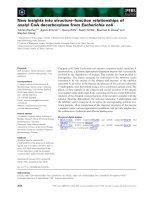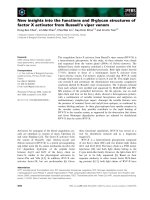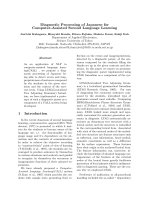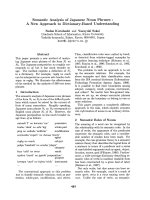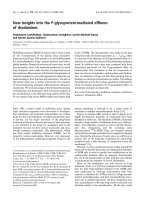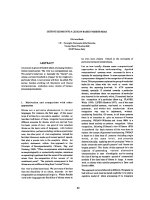Báo cáo khoa học: "Linefeed Insertion into Japanese Spoken Monologue for Captioning" pot
Bạn đang xem bản rút gọn của tài liệu. Xem và tải ngay bản đầy đủ của tài liệu tại đây (987.2 KB, 9 trang )
Proceedings of the 47th Annual Meeting of the ACL and the 4th IJCNLP of the AFNLP, pages 531–539,
Suntec, Singapore, 2-7 August 2009.
c
2009 ACL and AFNLP
Linefeed Insertion into Japanese Spoken Monologue for Captioning
Tomohiro Ohno
Graduate School of
International Development,
Nagoya University, Japan
Masaki Murata
Graduate School of
Information Science,
Nagoya University, Japan
Shigeki Matsubara
Information Technology Center,
Nagoya University, Japan
Abstract
To support the real-time understanding of
spoken monologue such as lectures and
commentaries, the development of a cap-
tioning system is required. In monologues,
since a sentence tends to be long, each
sentence is often displayed in multi lines
on one screen, it is necessary to insert
linefeeds into a text so that the text be-
comes easy to read. This paper proposes
a technique for inserting linefeeds into a
Japanese spoken monologue text as an el-
emental technique to generate the read-
able captions. Our method appropriately
inserts linefeeds into a sentence by ma-
chine learning, based on the information
such as dependencies, clause boundaries,
pauses and line length. An experiment us-
ing Japanese speech data has shown the ef-
fectiveness of our technique.
1 Introduction
Real-time captioning is a technique for support-
ing the speech understanding of deaf persons, el-
derly persons, or foreigners by displaying tran-
scribed texts of monologue speech such as lec-
tures. In recent years, there exist a lot of re-
searches about automatic captioning, and the tech-
niques of automatic speech recognition (ASR)
aimed for captioning have been developed (Bou-
lianne et al., 2006; Holter et al., 2000; Imai et
al., 2006; Munteanu et al., 2007; Saraclar et al.,
2002; Xue et al., 2006). However, in order to gen-
erate captions which is easy to read, it is important
not only to recognize speech with high recognition
rate but also to properly display the transcribed
text on a screen (Hoogenboom et al., 2008). Es-
pecially, in spoken monologue, since a sentence
tends to be long, each sentence is often displayed
as a multi-line text on a screen. Therefore, proper
linefeed insertion for the displayed text is desired
so that the text becomes easy to read.
Until now, there existed few researches about
how to display text on a screen in automatic cap-
tioning. As the research about linefeed insertion,
Monma et al. proposed a method based on pat-
terns of a sequence of morphemes (Monma et
al., 2003). However, the target of the research is
closed-captions of Japanese TV shows, in which
less than or equal to 2 lines text is displayed on
a screen and the text all switches to other text at
a time. In the work, the highest priority concept
on captioning is that one screen should be filled
with as much text as possible. Therefore, a se-
mantic boundary in a sentence is hardly taken into
account in linefeed insertion, and the readability
of the caption is hardly improved.
This paper proposes a technique for inserting
linefeeds into transcribed texts of Japanese mono-
logue speech as an elemental technique to gener-
ate readable captions. We assume that a screen for
displaying only multi-line caption is placed to pro-
vide the caption information to the audience on the
site of a lecture. In our method, the linefeeds are
inserted into only the boundaries between bunset-
sus
1
, and the linefeeds are appropriately inserted
into a sentence by machine learning, based on the
information such as morphemes, dependencies
2
,
clause boundaries, pauses and line length.
We conducted an experiment on inserting line-
feeds by using Japanese spoken monologue data.
As the results of inserting linefeeds for 1,714 sen-
tences, the recall and precision of our method were
82.66% and 80.24%, respectively. Our method
improved the performance dramatically compared
1
Bunsetsu is a linguistic unit in Japanese that roughly cor-
responds to a basic phrase in English. A bunsetsu consists of
one independent word and zero or more ancillary words.
2
A dependency in Japanese is a modification relation in
which a modifier bunsetsu depends on a modified bunsetsu.
That is, the modifier bunsetsu and the modified bunsetsu work
as modifier and modifyee, respectively.
531
Figure 1: Caption display of spoken monologue
with four baseline methods, which we established
for comparative evaluation. The effectiveness of
our method has been confirmed.
This paper is organized as follows: The next
section describes our assumed caption and the pre-
liminary analysis. Section 3 presents our linefeed
insertion technique. An experiment and discussion
are reported in Sections 4 and 5, respectively. Fi-
nally, Section 6 concludes the paper.
2 Linefeed Insertion for Spoken
Monologue
In our research, in an environment in which cap-
tions are displayed on the site of a lecture, we as-
sume that a screen for displaying only captions is
used. In the screen, multi lines are always dis-
played, being scrolled line by line. Figure 1 shows
our assumed environment in which captions are
displayed.
As shown in Figure 2, if the transcribed text of
speech is displayed in accordance with only the
width of a screen without considering the proper
points of linefeeds, the caption is not easy to read.
Especially, since the audience is forced to read
the caption in synchronization with the speaker’s
utterance speed, it is important that linefeeds are
properly inserted into the displayed text in consid-
eration of the readability as shown in Figure 3.
To investigate whether the line insertion facili-
tates the readability of the displayed texts, we con-
ducted an experiment using the transcribed text of
lecture speeches in the Simultaneous Interpreta-
tion Database (SIDB) (Matsubara et al., 2002). We
randomly selected 50 sentences from the data, and
then created the following two texts for each sen-
tence based on two different concepts about line-
feed insertion.
(1)Text into which linefeeds were forcibly in-
serted once every 20 characters
Figure 2: Caption of monologue speech
Figure 3: Caption into which linefeeds are prop-
erly inserted
Figure 4: Result of investigation of effect of line-
feed insertion into transcription
(2)Text into which linefeeds were properly
inserted in consideration of readability by
hand
3
Figure 2 and 3 show examples of the text (1) and
(2), respectively. 10 examinees decided which of
the two texts was more readable. Figure 4 shows
the result of the investigation. The ratio that each
examinee selected text (2) was 87.0% on average.
There was no sentence in the text group (1) which
was selected by more than 5 examinees. These
indicates that a text becomes more readable by
proper insertion of linefeeds.
Here, since a bunsetsu is the smallest seman-
tically meaningful language unit in Japanese, our
method adopts the bunsetsu boundaries as the can-
didates of points into which a linefeed is inserted.
In this paper, hereafter, we call a bunsetsu bound-
ary into which a linefeed is inserted a linefeed
point.
3
3 persons inserted linefeeds into the 50 sentences by dis-
cussing where to insert the linefeeds.
532
Table 1: Size of analysis data
sentence 221
bunsetsu 2,891
character 13,899
linefeed 883
character per line 13.2
3 Preliminary Analysis about Linefeed
Points
In our research, the points into which linefeeds
should be inserted is detected by using machine
learning. To find the effective features, we investi-
gated the spoken language corpus. In our investi-
gation, we used Japanese monologue speech data
in the SIDB (Matsubara et al., 2002). The data
is annotated by hand with information on mor-
phological analysis, bunsetsu segmentation, de-
pendency analysis, clause boundary detection, and
linefeeds insertion. Table 1 shows the size of the
analysis data. Among 2,670 (= 2, 891−221) bun-
setsu boundaries, which are candidates of linefeed
points, there existed 833 bunsetsu boundaries into
which linefeeds were inserted, that is, the ratio of
linefeed insertion was 31.2%.
The linefeeds were inserted by hand so that the
maximum number of characters per line is 20. We
set the number in consideration of the relation be-
tween readability and font size on the display. In
the analysis, we focused on the clause boundary,
dependency relation, line length, pause and mor-
pheme of line head, and investigated the relations
between them and linefeed points.
3.1 Clause Boundary and Linefeed Point
Since a clause is one of semantically meaningful
language units, the clause boundary is considered
to be a strong candidate of a linefeed point. In the
analysis data, there existed 969 clause boundaries
except sentence breaks. Among them, 490 were
the points into which linefeeds were inserted, that
is, the ratio of linefeed insertion was 51.1%. This
ratio is higher than that of bunsetsu boundaries.
This indicates that linefeeds tend to be inserted
into clause boundaries.
We investigated the ratio of linefeed insertion
about 42 types
4
of clause boundaries, which were
seen in the analysis data. Table 2 shows the top 10
4
In our research, we used the types of clause boundaries
defined by the Clause Boundary Annotation Program (Kash-
ioka and Maruyama, 2004).
Table 2: Ratio of linefeed insertion for clause
boundary type
type of ratio of linefeed
clause boundary insertion (%)
topicalized element-wa 50.8
discourse marker 12.0
quotational clause 22.1
adnominal clause 23.3
compound clause-te 90.2
supplement clause 68.0
compound clause-ga 100.0
compound clause-keredomo 100.0
condition clause-to 93.5
adnominal clause-toiu 27.3
clause boundary types about the occurrence fre-
quency, and each ratio of linefeed insertion. In
the case of “compound clause-ga” and “compound
clause-keredomo,” the ratio of linefeed insertion
was 100%. On the other hand, in the case of “quo-
tational clause,” “adnominal clause” and “adnomi-
nal clause-toiu,” the ratio of linefeed insertion was
less than 30%. This means that the likelihood of
linefeed insertion is different according to the type
of the clause boundary.
3.2 Dependency Structure and Linefeed
Point
When a bunsetsu depends on the next bunsetsu, it
is thought that a linefeed is hard to be inserted into
the bunsetsu boundary between them because the
sequence of such bunsetsus constitutes a semanti-
cally meaningful unit. In the analysis data, there
existed 1,459 bunsetsus which depend on the next
bunsetsu. Among the bunsetsu boundaries right
after them, 192 were linefeed points, that is, the
ratio of linefeed insertions was 13.2%. This ra-
tio is less than half of that for all the bunsetsu
boundaries. On the other hand, when the bunsetsu
boundary right after the bunsetsu which does not
depend on the next bunsetsu, the ratio of linefeed
insertion was 52.7%.
Next, we focused on the type of the dependency
relation, by which the likelihood of linefeed inser-
tion is different. For example, when the bunsetsu
boundary right after a bunsetsu on which the final
bunsetsu of an adnominal clause depends, the ra-
tio of linefeed insertion was 43.1%. This ratio is
higher than that for all the bunsetsu boundaries.
In addition, we investigated the relation be-
533
Figure 5: Relation between dependency structure
and linefeed points
tween a dependency structure and linefeed points,
that is, whether the dependency structure is closed
within a line or not. Here, a line whose depen-
dency structure is closed means that all bunsetsus,
except the final bunsetsu, in the line depend on one
of bunsetsus in the line. Since, in many of seman-
tically meaningful units, the dependency structure
is closed, the dependency structure of a line is con-
sidered to tend to be closed. In the analysis data,
among 883 lines, 599 lines’ dependency structures
were closed.
Figure 5 shows the relation between depen-
dency structure and linefeed points. In this exam-
ple, linefeeds are not inserted right after bunset-
sus which depend on the next bunsetsu (e.g. “私
の (my)” and “車を (car)”). Instead, a linefeed is
inserted right after a bunsetsu which does not de-
pend on the next bunsetsu (“記者が (a writer)”).
In addition, the dependency structure in each line
is closed.
3.3 Line Length and Linefeed Point
An extremely-short line is considered to be hardly
generated because the readability goes down if the
length of each line is very different. In the analysis
data, a line whose length is less than or equal to 6
characters occupied only 7.59% of the total. This
indicates that linefeeds tend to be inserted into the
place where a line can maintain a certain length.
3.4 Pause and Linefeed Point
It is thought that a pause corresponds to a syn-
tactic boundary. Therefore, there are possibility
that a linefeed becomes more easily inserted into
a bunsetsu boundary at which a pause exists. In
our research, a pause is defined as a silent interval
equal to or longer than 200ms. In the analysis data,
among 748 bunsetsu boundaries at which a pause
exists, linefeeds were inserted into 471 bunsetsu
boundaries, that is, the ratio of linefeed insertion
was 62.97%. This ratio is higher than that for all
the bunsetsu boundaries, thus, we confirmed that
linefeeds tend to be inserted into bunsetsu bound-
aries at which a pause exists.
3.5 Morpheme Located in the Start of a Line
There exist some morphemes which are unlikely
to become a line head. We investigated the ratio
that each leftmost morpheme of all the bunsetsus
appears at a line head. Here, we focused on the
basic form and part-of-speech of a morpheme. The
morphemes which appeared 20 times and of which
the ratio of appearance at a line head was less than
10% were as follows:
• Basic form:
“思 う (think) [2/70]”, “問 題 (problem)
[0/42]”, “する (do) [3/33]”, “なる (become)
[2/32]”,“必要 (necessary) [1/21]”
• Part-of-speech:
noun-non independent-general [0/40],
noun-nai adjective stem [0/40],
noun-non independent-adverbial [(0/27]
If the leftmost morpheme of a bunsetsu is one of
these, it is thought that a linefeed is hardly inserted
right after the bunsetsu.
4 Linefeed Insertion Technique
In our method, a sentence, on which morphologi-
cal analysis, bunsetsu segmentation, clause bound-
ary analysis and dependency analysis are per-
formed, is considered the input. Our method de-
cides whether or not to insert a linefeed into each
bunsetsu boundary in an input sentence. Under
the condition that the number of characters in each
line has to be less than or equal to the maximum
number of characters per line, our method identi-
fies the most appropriate combination among all
combinations of the points into which linefeeds
can be inserted, by using the probabilistic model.
In this paper, we describe an input sentence
which consists of n bunsetsus as B = b
1
···b
n
,
and the result of linefeeds insertion as R =
r
1
···r
n
. Here, r
i
is 1 if a linefeed is inserted right
after bunsetsu b
i
, and is 0 otherwise. We describe
a sequence of bunsetsus in the j-th line among the
m lines created by dividing an input sentence as
L
j
= b
j
1
···b
j
n
j
(1 ≤ j ≤ m), and then, r
j
k
= 0 if
k ̸= n
j
, and r
j
k
= 1 otherwise.
534
4.1 Probabilistic Model for Linefeed
Insertion
When an input sentence B is provided, our method
identifies the result of linefeeds insertion R, which
maximizes the conditional probability P (R|B).
Assuming that whether or not a linefeed is inserted
right after a bunsetsu is independent of other line-
feed points except the linefeed point of the start of
the line which contains the bunsetsu, P (R|B) can
be calculated as follows:
P (R|B) (1)
= P(r
1
1
= 0, ···, r
1
n
1
= 1, ···, r
m
1
= 0, ···, r
m
n
m
= 1|B)
∼
=
P (r
1
1
= 0|B) × P (r
1
2
= 0|r
1
1
= 0, B) ×···
×P (r
1
n
1
= 1|r
1
n
1
−1
= 0, ···, r
1
1
= 0, B) ×···
×P (r
m
1
= 0|r
m−1
n
m−1
= 1, B) ×···
×P (r
m
m
= 1|r
m
n
m
−1
= 0, ···, r
m
1
= 0, r
m−1
n
m−1
= 1, B)
where P (r
j
k
= 1|r
j
k−1
= 0, ···, r
j
1
= 0, r
j−1
n
j−1
=
1, B) is the probability that a linefeed is inserted
right after a bunsetsu b
j
k
when the sequence of
bunsetsus B is provided and the linefeed point of
the start of the j-th line is identified. Similarly,
P (r
j
k
= 0|r
j
k−1
= 0, ···, r
j
1
= 0, r
j−1
n
j−1
= 1, B)
is the probability that a linefeed is not inserted
right after a bunsetsu b
j
k
. These probabilities are
estimated by the maximum entropy method. The
result R which maximizes the conditional proba-
bility P (R|B) is regarded as the most appropriate
result of linefeed insertion, and calculated by dy-
namic programming.
4.2 Features on Maximum Entropy Method
To estimate P (r
j
k
= 1|r
j
k−1
= 0, ···, r
j
1
=
0, r
j−1
n
j−1
= 1, B) and P (r
j
k
= 0|r
j
k−1
=
0, ···, r
j
1
= 0, r
j−1
n
j−1
= 1, B) by the maximum
entropy method, we used the following features
based on the analysis described in Section 2.2.
Morphological information
• the rightmost independent morpheme (a part-
of-speech, an inflected form) and rightmost
morpheme (a part-of-speech) of a bunsetsu b
j
k
Clause boundary information
• whether or not a clause boundary exists right
after b
j
k
• a type of the clause boundary right after b
j
k
(if
there exists a clause boundary)
Dependency information
• whether or not b
j
k
depends on the next bun-
setsu
• whether or not b
j
k
depends on the final bun-
setsu of a clause
• whether or not b
j
k
depends on a bunsetsu to
which the number of characters from the start
of the line is less than or equal to the maxi-
mum number of characters
• whether or not b
j
k
is depended on by the final
bunsetsu of an adnominal clause
• whether or not b
j
k
is depended on by the bun-
setsu located right before it
• whether or not the dependency structure of
a sequence of bunsetsus between b
j
k
and b
j
1
,
which is the first bunsetsu of the line, is
closed
• whether or not there exists a bunsetsu which
depends on the modified bunsetsu of b
j
k
,
among bunsetsus which are located after b
j
k
and to which the number of characters from
the start of the line is less than or equal to the
maximum number of characters
Line length
• any of the following is the class into which
the number of characters from the start of the
line to b
j
k
is classified
– less than or equal to 2
– more than 2 and less than or equal to 6
– more than 6
Pause
• whether or not a pause exists right after b
j
k
Leftmost morpheme of a bunsetsu
• whether or not the basic form or part-of-
speech of the leftmost morpheme of the next
bunsetsu of b
j
k
is one of the morphemes enu-
merated in Section 3.5.
5 Experiment
To evaluate the effectiveness of our method, we
conducted an experiment on inserting linefeeds by
using discourse speech data.
5.1 Outline of Experiment
As the experimental data, we used the transcribed
data of Japanese discourse speech in the SIDB
(Matsubara et al., 2002). All the data are anno-
tated with information on morphological analysis,
clause boundary detection and dependency anal-
ysis by hand. We performed a cross-validation
experiment by using 16 discourses. That is, we
535
repeated the experiment, in which we used one
discourse from among 16 discourses as the test
data and the others as the learning data, 16 times.
However, since we used 2 discourse among 16
discourses as the preliminary analysis data, we
evaluated the experimental result for the other 14
discourses (1,714 sentences, 20,707 bunsetsus).
Here, we used the maximum entropy method tool
(Zhang, 2008) with the default options except “-i
2000.”
In the evaluation, we obtained recall, precision
and the ratio of sentences into which all linefeed
points were correctly inserted (hereinafter called
sentence accuracy). The recall and precision are
respectively defined as follows.
r ecall =
# of correctly inserted LFs
# of LF s in the correct data
pr ecision =
# of correctly inserted LFs
# of automatically inserted LF s
For comparison, we established the following
four baseline methods.
1. Linefeeds are inserted into the rightmost bun-
setsu boundaries among the bunsetsu bound-
aries into which linefeeds can be inserted so
that the length of the line does not exceed
the maximum number of characters (Line-
feed insertion based on bunsetsu bound-
aries).
2. Linefeeds are inserted into the all clause
boundaries (Linefeed insertion based on
clause boundaries).
3. Linefeeds are inserted between adjacent bun-
setsus which do not depend on each other
(Linefeed insertion based on dependency
relations).
4. Linefeeds are inserted into the all bunsetsu
boundaries in which a pause exists (Linefeed
insertion based on pauses).
In the baseline 2, 3 and 4, if each condition is not
fulfilled within the maximum number of charac-
ters, a linefeed is inserted into the rightmost bun-
setsu boundary as well as the baseline 1.
In the experiment, we defined the maximum
number of characters per line as 20. The cor-
rect data of linefeed insertion were created by ex-
perts who were familiar with displaying captions.
There existed 5,497 inserted linefeeds in the 14
discourses, which were used in the evaluation.
Table 3: Experimental results
recall (%) precision (%) F-measure
our method 82.66 80.24 81.43
(4,544/5,497) (4,544/5,663)
baseline 1 27.47 34.51 30.59
(1,510/5,497) (1,510/4,376)
baseline 2 69.34 48.65 57.19
(3,812/5,497) (3,812/7,834)
baseline 3 89.48 53.73 67.14
(4,919/5,497) (4,919/9,155)
baseline 4 69.84 55.60 61.91
(3,893/5,497) (3,893/6,905)
5.2 Experimental Result
Table 3 shows the experimental results of the base-
lines and our method. The baseline 1 is very sim-
ple method which inserts linefeeds into the bun-
setsu boundaries so that the length of the line does
not exceed the maximum number of characters per
line. Therefore, the recall and precision were the
lowest.
In the result of baseline 2, the precision was
low. As described in the Section 3.1, the degree
in which linefeeds are inserted varies in differ-
ent types of clause boundaries. In the baseline
2, because linefeeds are also inserted into clause
boundaries which have the tendency that linefeeds
are hardly inserted, the unnecessary linefeeds are
considered to have been inserted.
The recall of baseline 3 was very high. This
is because, in the correct data, linefeeds were
hardly inserted between two neighboring bunset-
sus which are in a dependency relation. However,
the precision was low, because, in the baseline
3, linefeeds are invariably inserted between two
neighboring bunsetsus which are not in a depen-
dency relation.
In the baseline 4, both the recall and precision
were not good. The possible reason is that the bun-
setsu boundaries at which a pause exists do not
necessarily correspond to the linefeed points.
On the other hand, the F-measure and the sen-
tence accuracy of our method were 81.43 and
53.15%, respectively. Both of them were highest
among those of the four baseline, which showed
an effectiveness of our method.
5.3 Causes of Incorrect Linefeed Insertion
In this section, we discuss the causes of the in-
correct linefeed insertion occurred in our method.
Among 1,119 incorrectly inserted linefeeds, the
most frequent cause was that linefeeds were in-
536
Figure 6: Example of incorrect linefeed insertion
in “adnominal clause.”
Figure 7: Example of extra linefeed insertion
serted into clause boundaries of a “adnominal
clause” type. The cause occupies 10.19% of the
total number of the incorrectly inserted linefeeds.
In the clause boundaries of the “adnominal clause”
type, linefeeds should rarely be inserted funda-
mentally. However, in the result of our method,
a lot of linefeeds were inserted into the “adnomi-
nal clause.” Figure 6 shows an example of those
results. In this example, a linefeed is inserted into
the “adnominal clause” boundary which is located
right after the bunsetsu “呼んでる (call).” The se-
mantic chunk “呼んでる時期でございます (is the
period which I call)” is divided.
As another cause, there existed 291 linefeeds
which divide otherwise one line according to the
correct data into two lines. Figure 7 shows an ex-
ample of the extra linefeed insertion. Although, in
the example, a linefeed is inserted between “どこ
まで詳しくお話しできるか (about how detail I
can speak)” and “不安ですが (I have a concern),”
the two lines are displayed in one line in the cor-
rect data. It is thought that, in our method, line-
feeds tend to be inserted even if a line has space to
spare.
6 Discussion
In this section, we discuss the experimental results
described in Section 5 to verify the effectiveness
of our method in more detail.
6.1 Subjective Evaluation of Linefeed
Insertion Result
The purpose of our research is to improve the read-
ability of the spoken monologue text by our line-
feed insertion. Therefore, we conducted a subjec-
tive evaluation of the texts which were generated
by the above-mentioned experiment.
In the subjective evaluation, examinees looked
at the two texts placed side-by-side between which
the only difference is linefeed points, and then se-
Figure 8: Result of subjective evaluation
lected the one which was felt more readable. Here,
we compared our method with the baseline 3, of
which F-measure was highest among four base-
lines described in Section 5.1. Ten examinees
evaluated 50 pairs of the results generated from
the same 50 randomly selected sentences.
Figure 8 shows the result of subjective evalua-
tion. This graph shows the number of each method
selected by each examinee. The ratio that our
method was selected was 94% in the highest case,
and 68% even in the lowest case. We confirmed
the effectiveness of our method for improving the
readability of the spoken monologue text.
On the other hand, there existed three sentences
for which more than 5 examinees judged that the
results of baseline 3 were more readable than those
of our method. From the analysis of the three sen-
tences, we found the following phenomena caused
text to be less readable
• Japanese syllabary characters (Hiragana) are
successionally displayed across a bunsetsu
boundary.
• The length of anteroposterior lines is ex-
tremely different each other.
Each example of the two causes is shown in
Figure 9 and 10, respectively. In Figure 9, a
bunsetsu boundary existed between Japanese syl-
labary characters “私もですね (I)” and “かくゆう
(if truth be told)” and these characters are succes-
sionally displayed in the same line. In these cases,
it becomes more difficult to identify the bunsetsu
boundary, therefore, the text is thought to become
difficult to read. In Figure 10, since the length of
the second line is extremely shorter than the first
line or third line, the text is thought to become dif-
ficult to read.
537
Figure 9: Example of succession of hiragana
Figure 10: Lines that have extremely different
length
Table 4: Other annotator’s results
recall (%) precision (%) F-measure
by human 89.82 (459/511) 89.82 (459/511) 89.82
our method 82.19 (420/511) 81.71 (420/514) 81.95
6.2 Comparison with Linefeeds Inserted by
Human
The concept of linefeed insertion for making the
caption be easy to read varies by the individual.
When multiple people insert linefeeds for the same
text, there is possibility that linefeeds are inserted
into different points.
Therefore, for one lecture data (128 sentences,
511 bunsetsus) in the experimental data, we con-
ducted an experiment on linefeed insertion by an
annotator who was not involved in the construc-
tion of the correct data. Table 4 shows the re-
call and the precision. The second line shows
the result of our method for the same lecture
data. In F-measure, our method achieved 91.24%
(81.95/89.82) of the result by the human annotator.
6.3 Performance of Linefeed Insertion Based
on Automatic Natural Language Analysis
In the experiment described in Section 5, we used
the linguistic information provided by human as
the features on the maximum entropy method.
However, compared with baseline 1, our method
uses a lot of linguistic information which should
be provided not by human but by natural language
analyzers under the real situation. Therefore, to
fairly evaluate our method and four baselines, we
conducted an experiment on linefeed insertion by
using the automatically provided information on
clause boundaries and dependency structures
5
.
5
We used CBAP (Kashioka and Maruyama, 2004) as
a clause boundary analyzer and CaboCha (Kudo and Mat-
sumoto, 2002) with default learning data as a dependency
parser.
Table 5: Experimental results when information of
features are automatically provided
recall (%) precision (%) F-measure
our method 77.37 75.04 76.18
(4,253/5,497) (4,253/5,668)
baseline 1 27.47 34.51 30.59
(1,510/5,497) (1,510/4,376)
baseline 2 69.51 48.63 57.23
(3,821/5,497) (3,821/7,857)
baseline 3 84.01 52.03 64.26
(4,618/5,497) (4,618/8,876)
baseline 4 69.84 55.60 61.91
(3,893/5,497) (3.893/6,905)
Table 5 shows the result. Compared with Table
3, it shows the decreasing rate of the performance
of our method was more than those of four base-
lines which use simply only basic linguistic infor-
mation. However, the F-measure of our method
was more than 10% higher than those of four base-
lines.
7 Conclusion
This paper proposed a method for inserting line-
feeds into discourse speech data. Our method can
insert linefeeds so that captions become easy to
read, by using machine learning techniques on fea-
tures such as morphemes, dependencies, clause
boundaries, pauses and line length. An experi-
ment by using transcribed data of Japanese dis-
course speech showed the recall and precision was
82.66% and 80.24%, respectively, and we con-
firmed the effectiveness of our method.
In applying the linefeed insertion technique to
practical real-time captioning, we have to consider
not only the readability but also the simultaneity.
Since the input of our method is a sentence which
tends to be long in spoken monologue, in the fu-
ture, we will develop more simultaneous a tech-
nique in which the input is shorter than a sentence.
In addition, we assumed the speech recognition
system with perfect performance. To demonstrate
practicality of our method for automatic speech
transcription, an experiment using a continuous
speech recognition system will be performed in
the future.
Acknowledgments
This research was partially supported by the
Grant-in-Aid for Scientific Research (B) (No.
20300058) and Young Scientists (B) (No.
21700157) of JSPS, and by The Asahi Glass
Foundation.
538
References
G. Boulianne, J F. Beaumont, M. Boisvert,
J. Brousseau, P. Cardinal, C. Chapdelaine,
M. Comeau, P. Ouellet, and F. Osterrath. 2006.
Computer-assisted closed-captioning of live TV
broadcasts in French. In Proceedings of 9th Interna-
tional Conference on Spoken Language Processing,
pages 273–276.
T. Holter, E. Harborg, M. H. Johnsen, and T. Svendsen.
2000. ASR-based subtitling of live TV-programs for
the hearing impaired. In Proceedings of 6th Interna-
tional Conference on Spoken Language Processing,
volume 3, pages 570–573.
R. B. Hoogenboom, K. Uehara, T. Kanazawa,
S. Nakano, H. Kuroki, S. Ino, and T. Ifukube. 2008.
An application of real-time captioning system using
automatic speech recognition technology to college
efl education for deaf and hard-of-hearing students.
Gunma University Annual Research Reports, Cul-
tural Science Series, 57.
T. Imai, S. Sato, A. Kobayashi, K. Onoe, and
S. Homma. 2006. Online speech detection
and dual-gender speech recognition for captioning
broadcast news. In Proceedings of 9th International
Conference on Spoken Language Processing, pages
1602–1605.
H. Kashioka and T. Maruyama. 2004. Segmentation of
semantic units in Japanese monologues. In Proceed-
ings of ICSLT2004 and Oriental-COCOSDA2004,
pages 87–92.
T. Kudo and Y. Matsumoto. 2002. Japanese depen-
dency analysis using cascaded chunking. In Pro-
ceedings of 6th Conference on Computational Natu-
ral Language Learning, pages 63–69.
S. Matsubara, A. Takagi, N. Kawaguchi, and Y. Ina-
gaki. 2002. Bilingual spoken monologue corpus
for simultaneous machine interpretation research.
In Proceedings of 3rd International Conference on
Language Resources and Evaluation, pages 153–
159.
T. Monma, E. Sawamura, T. Fukushima, I. Maruyama,
T. Ehara, and K. Shirai. 2003. Automatic closed-
caption production system on TV programs for
hearing-impaired people. Systems and Computers
in Japan, 34(13):71–82.
C. Munteanu, G. Penn, and R. Baecker. 2007. Web-
based language modelling for automatic lecture tran-
scription. In Proceedings of 8th Annual Conference
of the International Speech Communication Associ-
ation, pages 2353–2356.
M. Saraclar, M. Riley, E. Bocchieri, and V. Gof-
fin. 2002. Towards automatic closed captioning:
Low latency real time broadcast news transcription.
In Proceedings of 7th International Conference on
Spoken Language Processing, pages 1741–1744.
J. Xue, R. Hu, and Y. Zhao. 2006. New improvements
in decoding speed and latency for automatic caption-
ing. In Proceedings of 9th International Conference
on Spoken Language Processing, pages 1630–1633.
L. Zhang. 2008. Maximum entropy mod-
eling toolkit for Python and C++. http:
//homepages.inf.ed.ac.uk/s0450736/
maxent toolkit.html. [Online; accessed
1-March-2008].
539


